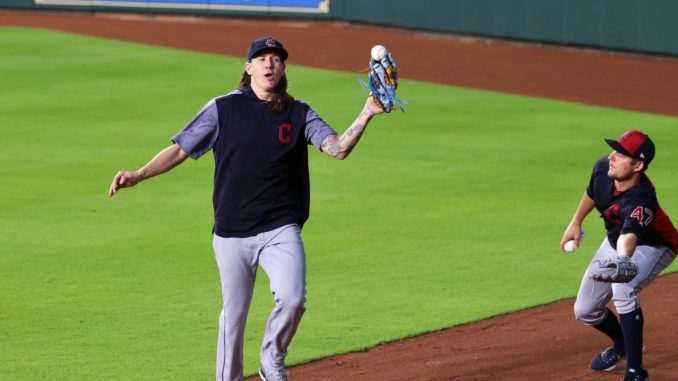
For the second year in a row, the Indians have made a major trade involving one of their top players. When a Cy Young candidate is traded from a contending team, fans always have questions. Here’s my attempt to answer the big ones.
What just happened?
After many months of speculation, the Cleveland Indians dealt RHP Mike Clevinger, OF Greg Allen and a player to be named to the San Diego Padres several hours before this year’s August 31 trade deadline. In return, the Indians received OF Josh Naylor, RHP Cal Quantrill, C Austin Hedges, SS Gabriel Arias, LHP Joey Cantillo and SS Owen Miller. Quantrill, Naylor and Hedges joined the major league club the night of the trade. Arias, Cantillo and Miller are not expected to see action in Cleveland this year.
Was that a good idea?
For the Padres, absolutely. San Diego has been riding a wave of momentum led by the continued emergence of Fernando Tatis Jr. As of August 31, the team is currently second in the NL West, five games behind the Los Angeles Dodgers. With the expanded playoffs this year, Clevinger bolsters an already strong pitching staff for a deep playoff run.
For the Indians, the trade provides an immediate modest improvement in a few areas of need. With Triston McKenzie taking advantage of the demotions of Clevinger and Zach Plesac, the Indians found themselves with six capable starters and five spots. Cleveland has already announced Plesac will take Clevinger’s spot in the rotation. While they’re different pitchers, Plesac is just as capable of getting major league hitters out. Clevinger ultimately became expendable.
In the near term, the Indians will have a stable left fielder in Naylor, a competent backup in Hedges and another weapon out of the bullpen in Quantrill. All three should help improve areas of need for the Indians in 2020.
Looking forward a few years, Arias and Miller immediately jump into the Indians’ exceptional group of Minor League middle infielders. With Francisco Lindor’s time in Cleveland likely drawing to a close, they’ll have an opportunity to earn a spot on the major league club within the next few years. Cantillo will be another project for the Indians’ pitching development staff. With the glut of middle infielders and pitchers in the system, these three players will either excel in Cleveland or be trade options for future deadline transactions.
The one question mark is the player to be named Cleveland will be sending after the season. The only thing we know so far is the player isn’t included on the 60-man player pool. If it winds up being a top prospect from the lower levels (Rocchio, Espino, Hankins, etc.), the dynamics of this trade shift dramatically.
So who are these guys?
Josh Naylor headlines this package. He’s best known for his bat, putting up a .288/.351/.417 line in his Minor League career, with SLG% increasing and K% decreasing as he advanced through the system. He’s relatively new to his outfield role. Naylor came up as a first baseman but was blocked by the Padres’ Eric Hosmer signing in 2018. He’s since transitioned to a corner outfield spot where his defense has been a work in progress. He’ll have the rest of 2020 to learn left field in Cleveland while getting consistent at-bats. Also worth noting, he’s the older brother of Indians’ 8th ranked prospect Bo Naylor.
#OTD in 2019, Josh Naylor (@JoshNaylor44) hit his 1st major league HR. pic.twitter.com/KYxEqf7k2q
— Padres On This Day (@padresOTD) June 1, 2020
Austin Hedges was once a highly regarded catching prospect, but his bat has never met lofty expectations. He won’t provide much offense, but his defense will likely vault him over Sandy Leon into the backup catcher role in Cleveland. With the expanded rosters, Roberto Perez, Hedges and Leon will likely be the Indians’ catchers for the rest of the season.
Cal Quantrill was the Padres’ first round pick in 2016. Quantrill came up as a starter, but he’s been utilized as a bullpen arm in San Diego. He brings a four-pitch mix with him, highlighted by a mid-90s fastball and above average changeup. He also mixes in a slider and curveball. It’s possible the Indians could eventually move Quantrill into the rotation and Carlos Carrasco to the bullpen. It’s also possible they could focus on his fastball and changeup and use him as a high-leverage out-getter to set up James Karinchak at the end of games.
Gabriel Arias headlines the prospect return. San Diego’s 8th ranked preseason prospect turned in a strong .302/.339/.470 line with A+ Lake Elsinore in 2019. He’ll turn 21 before the 2021 season, so Arias may have a season to prove himself in the Indians’ system before the shortstop position opens up in Cleveland. With another strong performance, he’ll be in the mix as the heir apparent to Francisco Lindor.
Joey Cantillo has the potential to be another Indians pitching development success story. The left-hander will be 21 years old at the start of the 2021 season, and he’ll likely start in A+ Lynchburg. Cantillo is 6’4” and has a fastball that can reach 94 mph. He’s added roughly 5 mph since he was drafted in 2017, and he may be able to add a bit more velocity as he matures. He utilizes a changeup as his go-to secondary pitch and has a curveball in his repertoire, also. Cantillo’s control could use some refining, but he still struck out more than 10 batters per nine innings in 2019.
Owen Miller is a contact-first hitter who played well in AA Amarillo last year, finishing with a .290/.355/.430 line. While his power may be limited, Miller maintains a reasonable K-rate around 15% and has a healthy 8.2 BB%. He projects as more of a utility player, but he has the athleticism to play virtually anywhere on the field.
Is that the best they could have done?
The Indians’ strategy in recent blockbuster trades has been to acquire the services of several solid, albeit not top-rated, prospects. In this regard, they succeeded. While it would have been nice to see a player like MacKenzie Gore or Trent Grisham come to Cleveland, the diversity of the new players will provide the best chance for a successful return.
Other rumors also involved the Braves, Yankees and Blue Jays, but all seemed to include a big-name bat like Drew Waters, Clint Frazier or Cavan Biggio. While all would have certainly been welcome additions, the potential for an unsuccessful trade is much higher when all your expectations lie with one or two players.
The Padres landed their prized starter without giving up any of their top five prospects or recent graduates like Jake Cronenworth or Grisham. They maintain their MLB-ready core without completely emptying their farm system. San Diego put itself in a great position.
What does this mean for both teams going forward?
The Padres are in win-now mode, and they’re now better suited to win. Mike Clevinger is a top-of-the-rotation starter, and he’ll have an immediate impact in San Diego. His strong peripherals coupled with pitcher-friendly Petco Park will only boost San Diego’s winning percentage. Greg Allen also provides a good defensive replacement and pinch running option for manager Jayce Tingler.
The Indians modestly improved this year’s team with Naylor’s bat and Quantrill’s arm. Some consistency in left field will be very welcome in an outfield that has had a different look nearly every night. Quantrill will provide an additional late-inning relief arm this year, and he may become a middle-of-the-rotation option in the future.
Cal Quantrill, Disgusting 95mph Two Seamer. 🤮 pic.twitter.com/S2Zr0AgAuc
— Rob Friedman (@PitchingNinja) August 21, 2019
Cleveland also added three developmental players who should reach Cleveland right when the championship window truly opens again around 2023. Arias, Cantillo and Miller all posses the natural talent to be key contributors at the major league level, and they’ll have the opportunity to prove themselves in the coming years. If the Indians choose to utilize different players, all three can also be valuable trade assets for future deadline deals.
Ultimately, both teams got what they needed. The Padres are in a better position to capitalize on their current success while the Indians have the pieces to sustain their recent success.





Leave a Reply